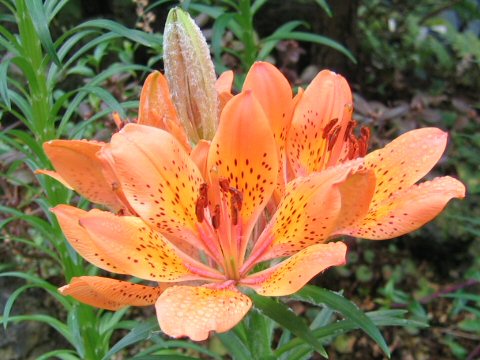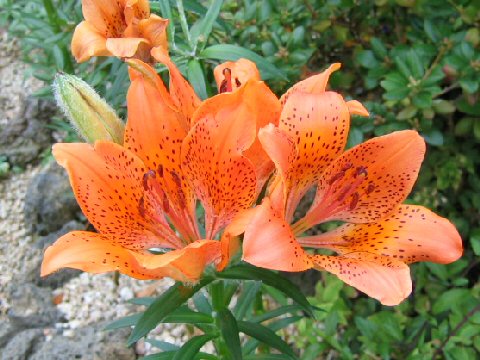
|
|
|
  |
|
|
|
わが国の北海道から千島列島、サハリンやシベリア、それに中国東北部に分布しています。海岸の砂地や草原に生え、高さは90センチほどになります。6月から7月ごろ、橙朱色にそばかすのような斑点がある花を咲かせます。花柄やつぼみには白い綿毛があります。和名は、花弁のあいだに透き間があることから。この鱗茎は食用にされ、北海道西部のアイヌ語方言では「マサロルンペ(masarorumpe)」、北海道東部の方言では「イマキパラ(imakipara)」または「イマキパラプ(imakiparap)」、樺太の方言では「エノンカイ(enonkay)」と呼ばれます。中国名では「毛百合(mao bai he)」です。 |
|
|
ユリ科ユリ属の多年草で、学名は Lilium maculatum ssp. dauricum。英名はありません。 |
|
|
"Ezo-sukashi-yuri" (Lilium maculatum ssp. dauricum) belongs to Liliaceae (the Lily family). It is a perennial herb that is distributed from Hokkaido in Japan to the Kuril Islands, Sakhalin, Siberia, and northeastern China. It grows in sandy coastal areas and grasslands, and produces orange-red flowers with freckle-like spots from June to July. The peduncle and buds have white wooly hairs. The Japanese name is derived from the spaces between the petals. The bulb is edible and is called "masarorumpe" in the Ainu dialect of western Hokkaido, "imakipara" or "imakiparap" in the dialect of eastern Hokkaido, and "enonkay" in the dialect of Sakhalin. The Chinese name is "毛百合" (mao bai he). |
|
|
[上] 大阪市鶴見区「咲くやこの花館」にて、2005年02月08日撮影。 [下] 同上にて、2004年09月16日撮影。 |

|
|
Shu Suehiro |